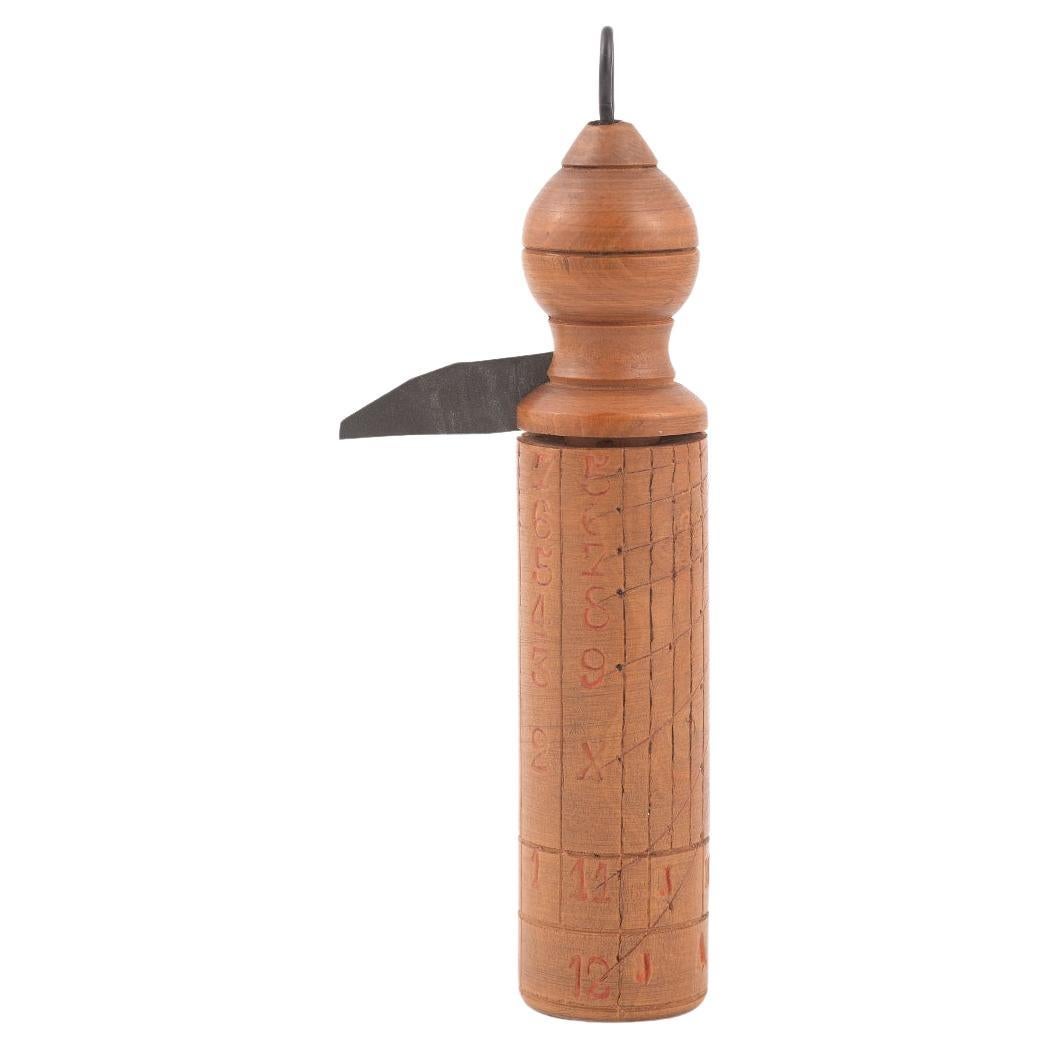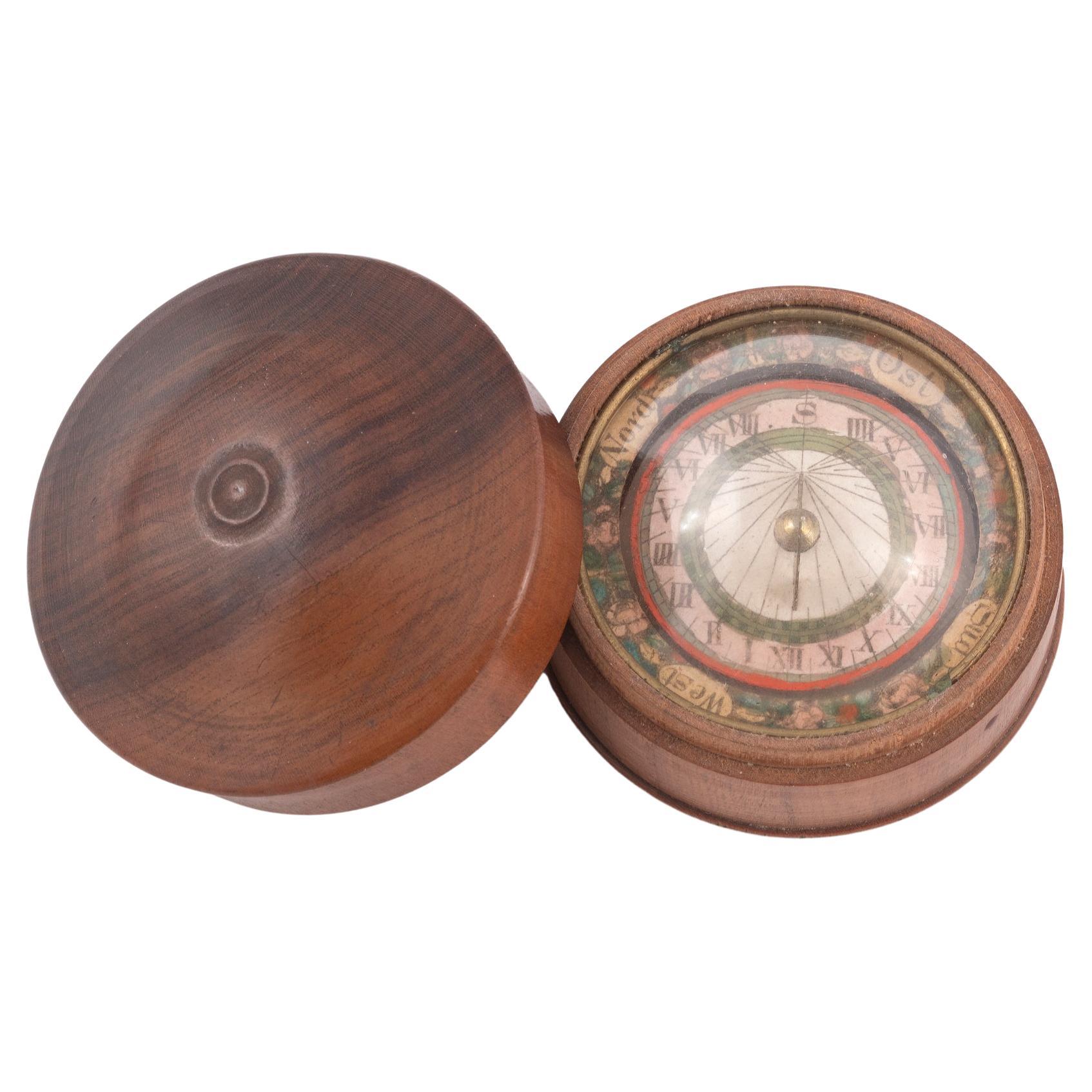Items Similar to Rare antique compass and sundial together England mid-19th century
Want more images or videos?
Request additional images or videos from the seller
1 of 11
Rare antique compass and sundial together England mid-19th century
About the Item
Rare antique compass and sundial together, mid-19th-century English manufacture, housed in a small brass box complete with lid. The Rose at sixteen winds, with daytime hour inscriptions in Roman numerals, printed on copperplate engraving paper and with a small gnomon in the center, hinges on the compass inside the concave protective glass. Orienting the compass northward, the movable gnomon casts a shadow on the hour scale.
Very good state of preservation fully functional.
Diameter cm 4.5 - inches 1.8, height cm 2.5 - inches 1.
The last photo is the gift box.
Curiosity
The sundial is a horizontal line passing through the North and South points. Sundial, in our language, is also synonymous with sundial. From ancient times to the present day, sundials have been made that varied in type, shape, and size, such as portable models that performed the functions of our wristwatches and pocket watches. Different peoples and different cultures then adopted various ways of measuring time according to their needs: in fact, ancient sundials can still be observed that do not follow the hours we use today (astronomical hours) but, for example, Babylonian hours, Italic hours, canonical hours, etc.
- Dimensions:Height: 1 in (2.54 cm)Diameter: 1.8 in (4.58 cm)
- Materials and Techniques:
- Period:
- Date of Manufacture:1850
- Condition:Wear consistent with age and use.
- Seller Location:Milan, IT
- Reference Number:1stDibs: LU1020239625532
About the Seller
4.9
Gold Seller
These expertly vetted sellers are highly rated and consistently exceed customer expectations.
Established in 1999
1stDibs seller since 2014
371 sales on 1stDibs
Typical response time: <1 hour
- ShippingRetrieving quote...Ships From: Milan, Italy
- Return PolicyA return for this item may be initiated within 14 days of delivery.
More From This SellerView All
- End 19th Century Antique Magnetic Topographic Compass Made in Brass and OakLocated in Milan, ITMagnetic topographic compass, of oak and brass; instrument consisting of a magnetized needle free to rotate on a horizontal plane, marking with the tip of the needle the direction of magnetic north, compass card with eight winds complete with goniometric circle divided into 360 °, complete with the compass needle lock. Italian manufacture of the late 19th century. Very good condition. Measure 3.1x3.1 height 1. Shipping is insured by Lloyd's London; our gift box is free (look at the last picture). The invention of the compass is mysterious but it is well known that magnetite was discovered in Magnesia, a city of Asia Minor. We can find the first indications about the use in Europe of the magnetic force for orientation at the end of the XII century...Category
Antique 1890s Italian Scientific Instruments
MaterialsOak
- Early 19th century equinoctial sundial clock signed S. Yeates 1762-1834Located in Milan, ITRare early 19th-century equinoctial sundial in turned and engraved brass, signed Samuel Yeates Dublin (1762-1834). Good working condition. Measures 9.5x2 cm - inches 3.8x0.7. The la...Category
Antique 1810s Scientific Instruments
MaterialsBrass
- Turned brass nautical travel compass English manufacture mid-19th scLocated in Milan, ITRare turned brass nautical travel compass complete with cover, rose on eight-wind paper complete with goniometric circle from copperplate engraving. English manufacture from the mid-...Category
Antique 1850s Nautical Objects
MaterialsBrass
- 19th Century English Chrome Plated Brass Cross-Legged Reduction CompassLocated in Milan, ITCross-legged reduction compass, of chrome plated brass and steel, English manufacture from the end of the 19th century. Fixed or mobile center, whose opposite points form simple re...Category
Antique 1890s Scientific Instruments
MaterialsBrass
- End 19th Century Ophthalmic Steel Surgery kitJ. Weiss & Son and Dixey EnglandLocated in Milan, ITOphthalmic steel surgery kit, signed J. Weiss & Son Ltd London and Dixey England, made in the end of XIX century circa, placed in its original wooden box covered with leather, red ve...Category
Antique Late 19th Century Scientific Instruments
MaterialsSteel
- Late 19th century Wooden and Brass Polarimeter Antique Physic InstrumentLocated in Milan, ITWooden and brass polarimeter with cast iron tripod base from the late 1800s. It is an instrument used to determine the concentration of sucrose and glucose in raw materials and sugar...Category
Antique 1890s British Scientific Instruments
MaterialsBrass
You May Also Like
- 19th Century Compass and Sundial TogetherLocated in Miami, FL19th century compass and sundial together.Category
Antique Late 19th Century French Baroque Scientific Instruments
MaterialsWood
- 19th Century, Compass and Sundial TogetherLocated in Miami, FL19th century, compass and sundial together.Category
Antique Late 19th Century French Baroque Scientific Instruments
MaterialsWood
- 19th Century French Table Sundial And CompassLocated in Firenze, ITShipping policy No additional costs will be added to this order. Shipping costs will be totally covered by the seller (customs duties included). Brass sundial with folding gnoman. ...Category
Antique Late 19th Century French Napoleon III Scientific Instruments
MaterialsBrass
- Antique Cylinder Sundial Late 19th CenturyLocated in Firenze, ITShipping policy No additional costs will be added to this order. Shipping costs will be totally covered by the seller (customs duties included). A boxwood cylinder sundial, also kn...Category
Antique Late 19th Century British Late Victorian Scientific Instruments
MaterialsWood, Paper
- 18th Century Diptych Portable Sundial And Compass by German BeringerBy David BeringerLocated in Milan, ITAntique 18th Century Diptych Sundial and Compass a portable wooden boxwood sundial with compass, of German origin, by David Beringer, Nuremberg, dating back to the 1790 circa, in good age related condition, with signs of wear consistent with age and use. David Beringer (1756 – 1821) was a German scientific instrument maker and craftsman active in Nuremberg and famous for his cubic wooden sundials visible in Metropolitan Museum of Art di New York. A portable sundial...Category
Antique Late 18th Century German Scientific Instruments
MaterialsBrass
- A Porter's Direction Sundial Germany Early 19th CenturyLocated in Firenze, ITThe printed and pivoted compass card and chapter ring centred by brass gnomon, in turned rosewood case with domed lid, (glass cover), 5cm (2in) diam.Category
Antique Early 19th Century German Neoclassical Scientific Instruments
MaterialsWood





